Key takeaways:
- Intersectional movements highlight the interconnectedness of various social identities, emphasizing the need for inclusive discussions that reflect diverse experiences.
- Political strategies must be tailored to address the overlapping nature of oppressions, ensuring that policies meet the specific needs of marginalized groups.
- Archives of political movements document historical struggles and victories, providing valuable insights for contemporary activism.
- Future intersectional activism is set to leverage digital platforms for broader engagement and will increasingly advocate for integrated approaches to social justice and environmental issues.
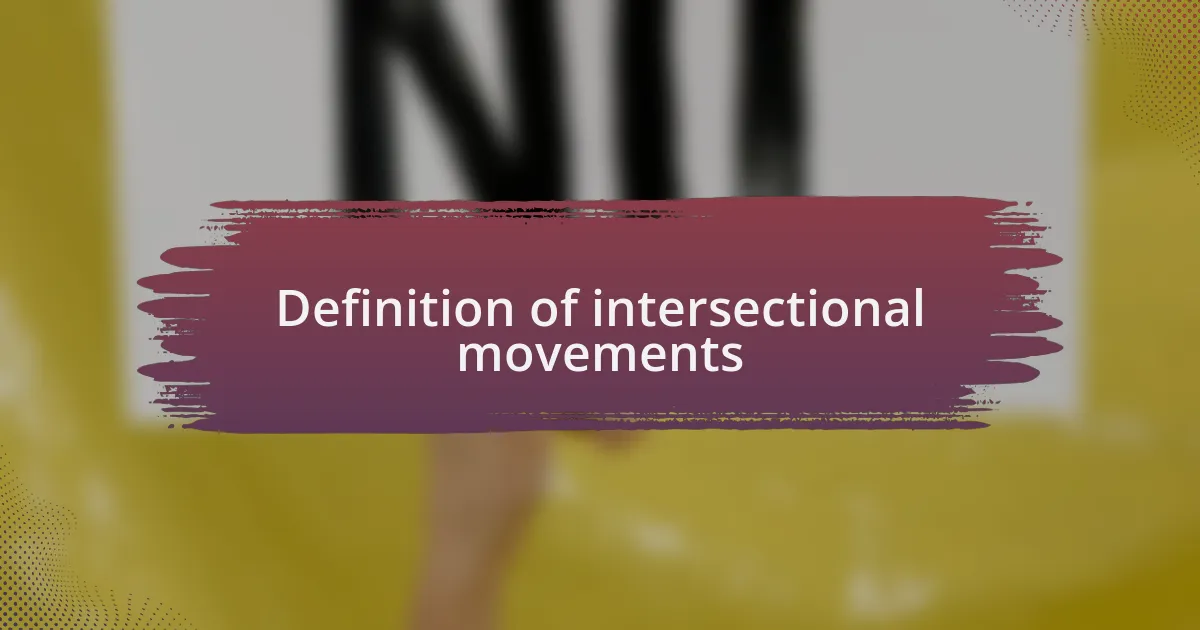
Definition of intersectional movements
Intersectional movements are rooted in the understanding that individuals experience social injustices on multiple levels, depending on their varying identities, such as race, gender, class, and sexuality. This concept emphasizes that we cannot address inequities in isolation; rather, we must recognize how these identities intersect to affect someone’s experiences. Have you ever considered how a black woman might face different challenges than a white woman or a black man?
I recall attending a workshop on intersectionality, where people shared their stories. Hearing firsthand accounts of how systemic issues overlap filled me with a profound understanding of the importance of intersectional perspectives. It struck me how critical it is to acknowledge not just one aspect of a person’s identity but the entire spectrum, as this shapes their reality in powerful ways.
Moreover, intersectional movements push for more inclusive discussions that reflect the diverse experiences of marginalized groups. They challenge the dominant narratives that often overlook the unique struggles faced by individuals at these intersections. Isn’t it essential for movements to adapt and become more reflective of the world we live in? Embracing intersectionality means fostering solidarity among various groups, ensuring everyone’s voice resonates in the fight for equality.
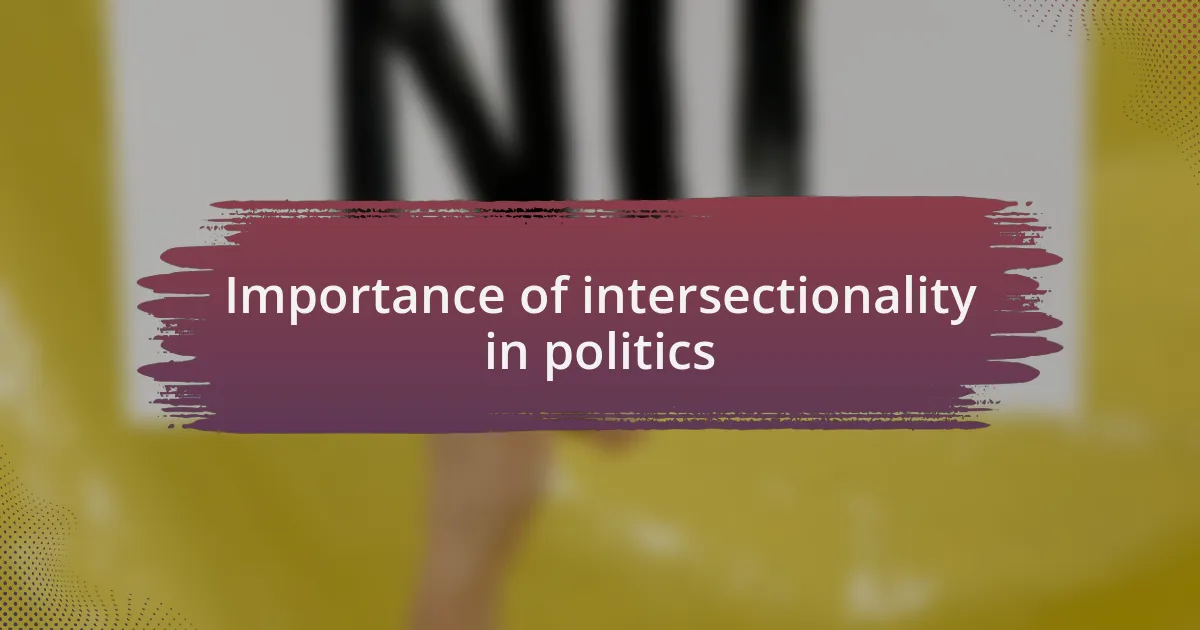
Importance of intersectionality in politics
The importance of intersectionality in politics cannot be overstated, as it fosters a more nuanced understanding of social issues. I’ve often found that when policies are designed without considering intersecting identities, they tend to miss critical needs. For example, a health initiative aimed solely at women may neglect specific challenges faced by women of color, limiting its effectiveness and ultimately perpetuating inequities.
It strikes me how intersectionality enables us to visualize a more inclusive political landscape. During a recent community meeting, I noticed that conversations about housing policies were richer and more impactful when individuals shared their experiences through the lens of their intersectional identities. This collective storytelling illuminated issues that might have seemed abstract, and it became evident just how much more vibrant our political discourse could be by embracing various viewpoints. Wouldn’t you agree that listening to a chorus of voices ensures that no one is left behind?
Ultimately, intersectionality emphasizes the urgency of tailoring political strategies to tackle the interconnected nature of oppressions. I remember hearing from a local activist who advocated for immigrant rights, highlighting how her work intertwines with issues of race, gender, and class. This intricate dance of identities illustrates that any effective political movement must confront multiple layers of injustice to resonate authentically and drive real change.
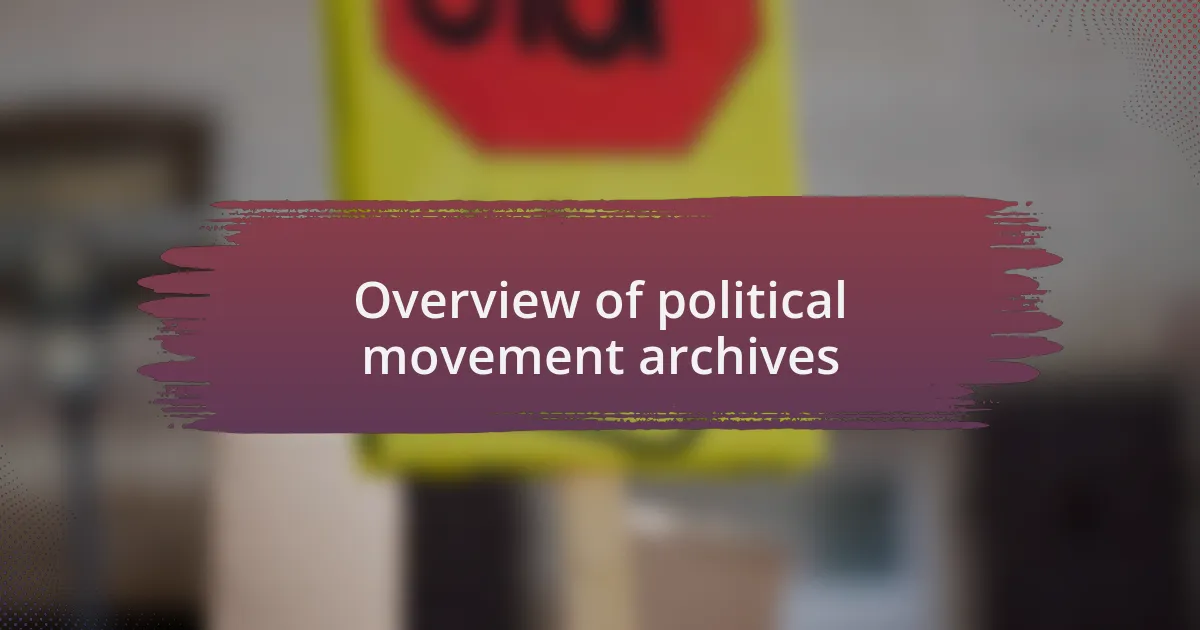
Overview of political movement archives
Political movement archives serve as vital repositories that document the evolution of various social justice efforts. I find it fascinating how these archives not only preserve historical records but also illuminate the struggles and victories of those who came before us. They enable us to explore the interconnectedness of movements, revealing patterns and strategies that have shaped our contemporary political landscape.
Through my research, I’ve often stumbled upon archived materials that sparked a deeper understanding of the past. I distinctly remember discovering a collection of flyers from a 1970s feminist group, which brilliantly showcased their intersectional approach to activism. This experience was eye-opening; it reminded me that the lessons from past movements can guide current and future efforts. Isn’t it remarkable how much insight we can gain by examining the paths taken in the fight for justice?
Moreover, these archives play a crucial role in fostering dialogue and education about lesser-known movements. I once participated in a workshop that featured an archive focused on the civil rights struggles of + individuals. The stories illuminated not just the challenges they faced, but also the vibrant community solidarity that emerged in response. This experience reinforced my belief that understanding the intersections of activism can empower us to advocate more effectively in today’s world. How can we expect to move forward without understanding where we’ve been?
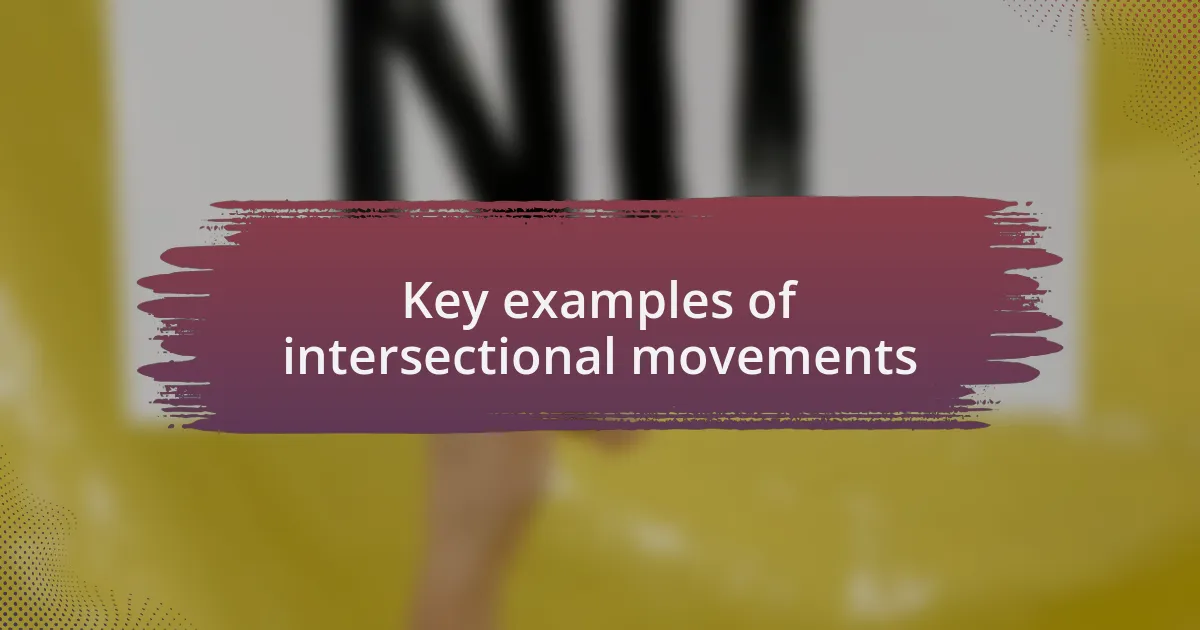
Key examples of intersectional movements
One of the most compelling examples of an intersectional movement is the Black Lives Matter (BLM) movement. As I reflect on its rise, I remember attending a local protest where the organizers emphasized the importance of including voices from various communities, such as those of women, + individuals, and the disabled. This inclusivity reminded me that addressing issues of police violence and systemic racism is inherently connected to the struggles of many marginalized groups. Isn’t it inspiring how a single movement can unite diverse experiences and create a powerful collective voice?
Another powerful instance is the Women’s March, which began in 2017. I vividly recall the palpable energy swirling through the crowd as individuals from all walks of life came together. The event was a beautiful representation of intersectionality, as it focused not only on women’s rights but also on immigrant rights, reproductive rights, and racial justice. It was refreshing to see people advocating for inclusive policies that resonated with far more than just one demographic. Don’t you think it’s essential to recognize that the fight for equality encompasses multiple layers of identity?
Additionally, the climate justice movement is increasingly highlighting intersectionality. I was struck during a recent community forum by how activists connected environmental issues to social justice, emphasizing that marginalized communities are often the hardest hit by climate change. This intersection makes it clear that addressing ecological crises cannot happen in a vacuum. How can we expect to build a sustainable future if we leave behind those who are already facing the brunt of environmental neglect?
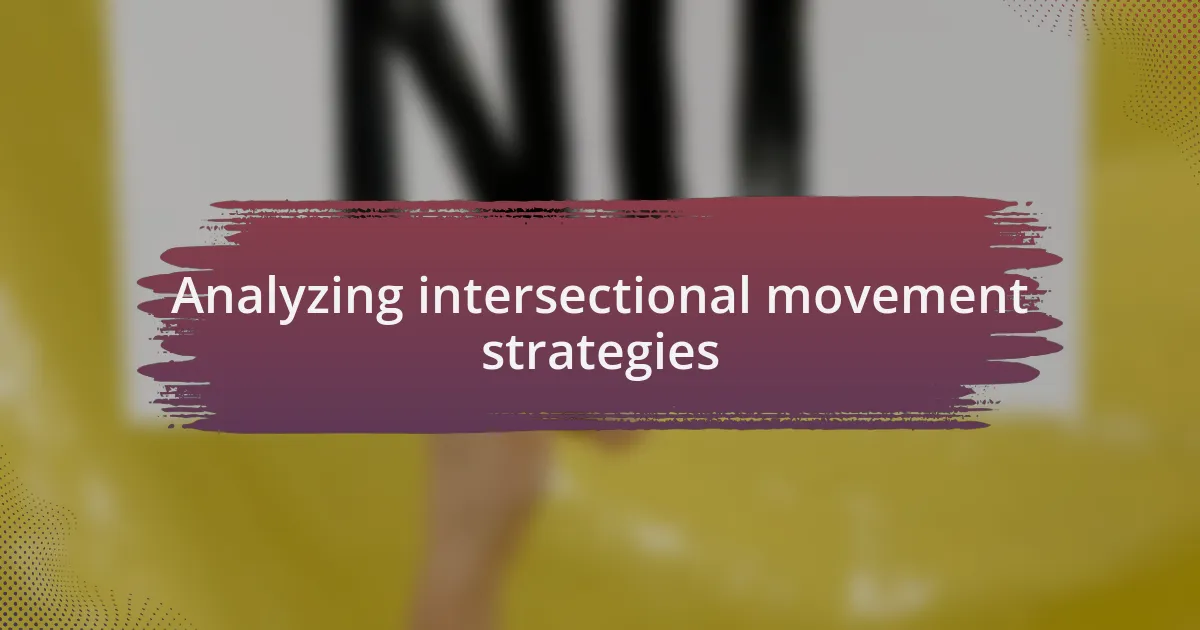
Analyzing intersectional movement strategies
Analyzing the strategies of intersectional movements reveals a profound understanding of the interconnected nature of social issues. I remember a workshop I attended focused on coalition-building, where facilitators emphasized that successful strategies should engage diverse communities rather than isolating them. This collaborative approach fosters solidarity and empowers marginalized voices, enabling movements to resonate with a broader audience. Isn’t it fascinating how shared struggles can form the backbone of powerful advocacy?
Another observation I’ve made is that intersectional movements often utilize storytelling as a key strategy. At a recent panel discussion, speakers shared their personal experiences with discrimination and injustice, illustrating the real-life impacts of policy decisions. It was a poignant reminder that statistics alone can’t capture the essence of the struggle. By humanizing these issues, activists can effectively engage allies and spark empathy in those who might not have considered the intersections before.
Furthermore, I find that successful intersectional movements adopt a multifaceted approach to advocacy, targeting various systems of oppression simultaneously. During a recent community gathering, I witnessed activists working together to address issues ranging from criminal justice reform to economic inequality, reminding me how interconnected these challenges truly are. This holistic strategy encourages a more comprehensive response to injustice, and it raises the question: how can we truly achieve progress if we only tackle one issue at a time?

Personal reflections on intersectional movements
Thinking about intersectional movements brings back vivid memories of a community event I attended, where activists from various backgrounds shared their unique journeys. It was eye-opening to witness how their stories intertwined, revealing not only the struggle but also moments of resilience and collective strength. I couldn’t help but wonder: how much richer could our understanding of social issues become if we truly listened to each other?
Reflecting on my own experiences, I often recall a time when I participated in a local campaign that aimed to unite different marginalized groups. The energy and enthusiasm were palpable, but what struck me the most was the realization that our differences could serve as our greatest asset. I remember feeling inspired as we brainstormed ways to address systemic racism and sexism simultaneously, which led me to believe that only through collaboration can we hope to dismantle these entrenched barriers.
I have often marveled at the power of intersectional movements to challenge conventional narratives. A workshop I joined where participants identified various privileges and oppressions made me rethink my position within these frameworks. It was sobering yet empowering to realize that the root of our struggles often lies in the same social systems we fight against. How could we ignore these crucial intersections in our advocacy efforts? Seems clear to me that understanding these layers is essential for creating lasting social change.
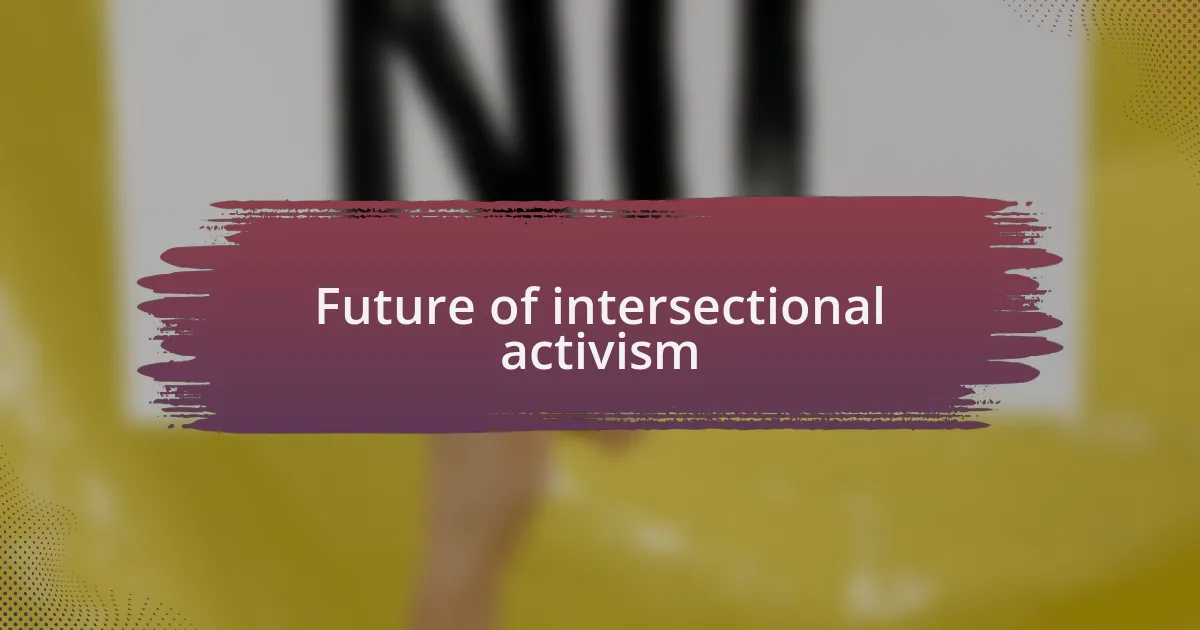
Future of intersectional activism
The future of intersectional activism is filled with potential, as I see more individuals recognizing the importance of shared experiences. I often reflect on the recent gatherings where diverse coalitions formed around common goals. It struck me how, through these collaborations, we can amplify marginalized voices, paving the way for more inclusive policies that address the needs of various groups concurrently.
I’ve noticed a growing trend toward digital activism, which has the power to reach wider audiences and engage people who once felt isolated. As I participated in an online forum for change, it felt like barriers were breaking down. Why should geographic distance limit our solidarity? It’s exciting to think about how technology can facilitate intersectional dialogue, empowering activists to explore and address overlapping oppressions in real-time.
Looking ahead, I believe intersectional movements will increasingly challenge the status quo in innovative ways. Just last week, I attended a roundtable discussion where young activists presented proposals that intertwine climate action and social justice. It made me think, how could a united front on these issues transform our society? I’m convinced that continuing this trend will not only enrich our activism but also create a more equitable world for future generations.